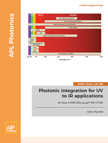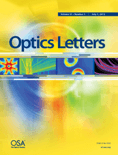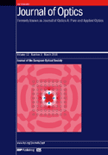
APL Photonics
Scope & Guideline
Transforming Ideas into Photonic Breakthroughs
Introduction
Aims and Scopes
- Photonics and Optoelectronics:
Research in this area involves the development and application of devices and systems that utilize light for various purposes, including communication, sensing, and imaging. - Quantum Photonics:
This scope focuses on the generation, manipulation, and detection of quantum states of light, exploring applications in quantum computing, quantum communication, and quantum sensing. - Nanophotonics:
Studies in nanophotonics examine the interaction of light with nanostructured materials, leading to advancements in light manipulation and new functionalities in photonic devices. - Biomedical Applications:
Research related to photonics in the biomedical field includes optical imaging techniques, biosensing, and therapeutic applications, highlighting the role of photonics in healthcare. - Nonlinear Optics:
This area explores the interaction of light with matter under high-intensity conditions, leading to phenomena such as frequency mixing, solitons, and optical switching. - Integrated Photonics:
Research focused on the integration of photonic devices onto a single chip, enhancing functionality and performance while reducing size and cost. - Metamaterials and Plasmonics:
Investigations into engineered materials that exhibit unique optical properties not found in nature, enabling novel applications in sensing, imaging, and light manipulation.
Trending and Emerging
- Artificial Intelligence in Photonics:
The integration of AI and machine learning techniques in photonics research is rapidly growing, enabling enhanced design, optimization, and analysis of photonic systems. - Quantum Technologies:
Research focusing on quantum photonics, including quantum communication, cryptography, and quantum sensing, is on the rise, driven by advancements in quantum information science. - Biophotonics and Medical Imaging:
There is an increasing emphasis on the development of novel imaging and sensing techniques for biomedical applications, reflecting the growing intersection of photonics and healthcare. - Terahertz Photonics:
Research into terahertz technologies, including imaging and sensing applications, is gaining traction as new materials and devices are developed for this spectral range. - Metasurfaces and Topological Photonics:
The exploration of metasurfaces and topological photonics is trending, with a focus on their unique properties and potential applications in advanced photonic devices. - Integrated Quantum Photonics:
As quantum computing progresses, integrated quantum photonic systems are emerging as a key area of research, combining scalability with the advantages of quantum technologies.
Declining or Waning
- Traditional Optical Devices:
Research focused on conventional optical devices, such as basic lenses and mirrors, appears to be waning as the field moves toward more advanced, integrated, and multifunctional photonic systems. - Basic Photonic Theory:
While foundational theories remain important, there is a noticeable decline in publications emphasizing purely theoretical studies without practical applications or experimental validation. - Low-Dimensional Materials:
Interest in low-dimensional materials, while still relevant, has seen a reduction in the number of publications compared to the rising focus on hybrid and integrated photonic systems. - Conventional Spectroscopy Techniques:
Traditional spectroscopy methods are being overshadowed by more advanced techniques that incorporate machine learning and novel materials, leading to a decline in interest in standard methods.
Similar Journals

PhotoniX
Bridging Theory and Application in PhotonicsPhotoniX is a premier open-access journal published by SPRINGERNATURE in Germany, dedicated to the fields of Atomic and Molecular Physics, Optics, and Electrical and Electronic Engineering. Launched in 2020, this journal has swiftly established itself as a key resource within the scientific community, achieving impressive rankings, notably being placed in the Q1 quartile across its categories in 2023. With its Scopus ranks highlighting its excellence—2nd in Engineering (Miscellaneous), 9th in Electrical and Electronic Engineering, and 6th in Atomic and Molecular Physics—PhotoniX serves as a critical platform for researchers to disseminate their findings. With an emphasis on broadening access to cutting-edge research, the journal offers a valuable opportunity for engagement with contemporary advancements in the fields it covers. Researchers, professionals, and students can benefit significantly from its contents, contributing to the collective knowledge in these vital areas of science and technology.

Journal of Nanophotonics
Transforming Ideas into Nanophotonic RealitiesThe Journal of Nanophotonics, published by SPIE-SOC Photo-Optical Instrumentation Engineers, is an esteemed platform dedicated to advancing the field of nanotechnology through pioneering research in photonics. Since its inception in 2007, this journal has become instrumental in disseminating innovative findings and fostering collaborative discussions, especially in the domains of Condensed Matter Physics, Electronic, Optical and Magnetic Materials, and Nanoscience and Nanotechnology. Currently ranked within the Q3 category across these fields, it serves as a vital resource for academics, industry professionals, and students keen on exploring the multifaceted applications and implications of nanophotonic technologies. With its convergence set to continue until 2024, the journal offers a non-open-access model, ensuring rigorous peer-review standards and high-quality publications that contribute to the global body of knowledge.

Opto-Electronic Advances
Advancing the Frontiers of Opto-ElectronicsOpto-Electronic Advances is a premier open-access journal published by the Chinese Academy of Sciences' Institute of Optics & Electronics, dedicated to advancing the fields of optics and electronic engineering. Established in 2018, this journal quickly ascended to a Q1 ranking across multiple categories including Atomic and Molecular Physics, Electrical and Electronic Engineering, and Electronic, Optical and Magnetic Materials, showcasing its impact and relevance in the scientific community. With an impressive Scopus ranking placing it in the top percentiles for critical fields such as Engineering, Materials Science, and Physics, Opto-Electronic Advances provides a platform for researchers to publish their cutting-edge findings and foster dialogue in an increasingly interdisciplinary area of study. The journal emphasizes innovative research that contributes to practical applications and theoretical frameworks in its domain, making it an invaluable resource for academicians, industry practitioners, and students alike. Embrace the future of opto-electronic research with Opto-Electronic Advances, which has been fully open access since 2021, ensuring that knowledge is widely disseminated without barriers.

Journal of the European Optical Society-Rapid Publications
Catalyzing Breakthroughs in Optical TechnologyJournal of the European Optical Society-Rapid Publications, with ISSN 1990-2573 and published by EDP Sciences S A, is a premier open access journal dedicated to advancing the field of optics and photonics since its inception in 2006. Based in France, this journal serves as a vibrant platform for researchers, professionals, and students to disseminate their findings quickly and efficiently. Achieving a commendable Q3 ranking in Atomic and Molecular Physics and Optics (2023), it reflects a growing impact within the scientific community, despite currently holding a 33rd percentile rank among similar publications in the realm of Physics and Astronomy. The journal fosters an environment of rapid communication and collaboration, making it an invaluable resource for those interested in the latest developments and innovations in optical sciences. With open access ensuring broad visibility for all published work, the Journal of the European Optical Society-Rapid Publications is positioned as a key contributor to enhancing the understanding and application of optical technologies.

ACTA OPTICA SINICA
Advancing Discoveries in Light and MaterialsACTA OPTICA SINICA is a distinguished journal dedicated to the field of optics and photonics, published by the Chinese Laser Press. With an ISSN of 0253-2239, this journal has been an essential resource since its inception, covering significant discoveries and advancements in atomic and molecular physics, electronic materials, and optical sciences. The journal is indexed in Scopus, achieving respectable ranks as Q3 in both Atomic and Molecular Physics, and Optics and Electronic, Optical and Magnetic Materials, reflecting its engagement with current research trends. Although it is not an open-access journal, ACTA OPTICA SINICA is hosted from Shanghai, China, and continues to serve as a vital platform for researchers, professionals, and students alike to disseminate and access high-quality peer-reviewed articles, ensuring its prominent place in the academic discourse related to optics and material sciences.

Chinese Optics
Pioneering Discoveries in the Realm of Optical Sciences.Chinese Optics is a premier journal dedicated to advancing the field of optics, encompassing research on atomic and molecular physics. Published by the esteemed Changchun Institute of Optics Fine Mechanics & Physics in China, this journal supports the sharing of cutting-edge findings since its inception in 2010. With an ISSN of 2097-1842, it operates within a competitive landscape, currently positioned in Q3 of the category for Atomic and Molecular Physics and Optics, according to the 2023 metrics. While the journal is not open access, it offers a valuable platform for researchers, professionals, and students to explore and contribute to significant discoveries in the realm of optics and light technology. By fostering scholarly communication, Chinese Optics plays a crucial role in bridging theoretical and practical aspects, making it an indispensable resource for those passionate about the optical sciences.

OPTICS LETTERS
Your Gateway to High-Impact Optical DiscoveriesOPTICS LETTERS is a premier academic journal published by the Optica Publishing Group, dedicated to advancing the field of optics and photonics. Since its inception in 1977, it has maintained a strong reputation for publishing high-impact research, holding a distinguished Q1 category ranking in Atomic and Molecular Physics, as well as Optics, making it a vital resource for researchers and professionals alike. With an impressive Scopus rank of #55 out of 224 in its field, OPTICS LETTERS continues to shape the discourse and innovation in optical science. Authors benefit from its extensive international reach, while readers gain access to cutting-edge studies that address both theoretical and applied aspects of optics. Although the journal currently does not offer open access options, its rigorous peer-review standards ensure that every publication meets the highest academic criteria, making it an essential journal for anyone looking to stay at the forefront of optical research.

Journal of Optics
Advancing Knowledge in Light and MatterThe Journal of Optics, published by IOP Publishing Ltd, stands as a pivotal platform for disseminating cutting-edge research in the fields of atomic, molecular physics, and optics as well as electronic, optical, and magnetic materials. With an impact factor reflective of its esteemed position—ranking in the 60th percentile in both relevant Scopus categories—this journal, boasting an ISSN of 2040-8978 and an E-ISSN of 2040-8986, is uniquely positioned to foster innovation and collaboration among researchers, professionals, and students worldwide. Located in the United Kingdom and operational since 2010, the journal embraces an open access model, promoting maximal reach and engagement with the latest discoveries that shape the future of optics. As it continues to evolve through its converged years up to 2024, the Journal of Optics remains a critical resource for those seeking to advance their knowledge and influence in this dynamic field.

Journal of Optics-India
Shaping the Future of Optics ResearchThe Journal of Optics-India, published by SPRINGER INDIA, serves as a vital platform dedicated to advancing research in the field of optics, focusing on topics in both atomic and molecular physics. With an ISSN of 0972-8821 and an E-ISSN of 0974-6900, the journal has been a consistent contributor to the field since its inception in 1996 and continues to thrive with its anticipated convergence through 2024. Although currently classified in Q3 of the 2023 category quartiles, the journal actively seeks to elevate its standing within Scopus rankings in physics and astronomy, where it holds a rank of 143/224, indicating significant opportunities for growth and research impact. The Journal of Optics-India is committed to fostering innovative research and providing scholars and practitioners with access to cutting-edge findings, thereby enhancing global conversations around optics and its vast applications. As a reliable source for researchers, professionals, and students alike, the journal emphasizes quality contributions that shape the future of optical science.

Nonlinear Optics Quantum Optics-Concepts in Modern Optics
Bridging Theory and Application in Optical PhenomenaNonlinear Optics Quantum Optics-Concepts in Modern Optics is a specialized journal published by OLD CITY PUBLISHING INC, focusing on the forefront of research in nonlinear optics and quantum optics. With an ISSN of 1543-0537 and an E-ISSN of 1944-8325, this journal serves as a pivotal platform for the dissemination of innovative concepts and findings in modern optics, significant for both theoretical exploration and practical applications. Established in 2003, the journal's scope encompasses critical areas such as atomic and molecular physics, optical materials, and instrumentation, attracting submissions from a diverse range of interdisciplinary fields. While the journal currently maintains a Q4 ranking in several categories, it continues to strive for higher visibility and impact in the academic community. Researchers and students alike will find valuable insights and contributions that foster advancements in optical science and engineering. With an emphasis on rigorous peer-review, Nonlinear Optics Quantum Optics-Concepts in Modern Optics is committed to enhancing the understanding and application of nonlinear optical phenomena in various technological domains.